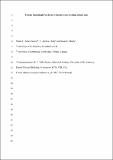Female hummingbirds do not relocate rewards using colour cues
Abstract
Males generally outperform females in spatial tasks. This difference in spatial performance may reflect differences in cue preference because males often use both spatial cues 9distance and direction) and feature cues, whereas females prefer to use feature cues. However, studies in birds are few and results are conflicting. As wild male rufous hummingbirds, Selasphorus rufus, prefer to use spatial cues to relocate a rewarded flower, in the present study we tested free-flying wild female hummingbirds of three different species 9rufous, white-eared, Hylocharis leucotis, and magnificent hummingbird, Eugenes fulgens) and males of one species 9white-eared) for their cue preference in the same task in which rufous males have been tested previously. Birds were allowed to feed once from a four-flower array in which only one flower was rewarded. When the birds returned, the colour and the spatial cue designating the rewarded flower had been dissociated. Although we had expected females to visit the flower of the correct colour 9feature cue) first, during the test phase most of the birds 9males and females) went to the correct spatial location 9spatial cue). It appears, then, that preference for spatial cues is not specific to males and it seems more likely to depend on the relevance or value of a cue to the solution of the task. (C) 2014 The Association for the Study of Animal Behaviour. Published by Elsevier Ltd. All rights reserved.
Citation
Tello Ramos , M C , Hurly , T A & Healy , S D 2014 , ' Female hummingbirds do not relocate rewards using colour cues ' , Animal Behaviour , vol. 93 , pp. 129-133 . https://doi.org/10.1016/j.anbehav.2014.04.036
Publication
Animal Behaviour
Status
Peer reviewed
ISSN
0003-3472Type
Journal article
Description
This research was supported by CONACYT (The Mexican National Council for Science and Technology) grant number: 310717, the University of Lethbridge and the Natural Sciences and Engineering Research Council of Canada (grant number: RGPIN 121496-2003) and the University of St Andrew's Russell Trust Award.Collections
Items in the St Andrews Research Repository are protected by copyright, with all rights reserved, unless otherwise indicated.
Related items
Showing items related by title, author, creator and subject.
-
What, where and when : deconstructing memory
Marshall, Rachael; Hurly, T.Andrew; Sturgeon, Jenny; Shuker, David Michael; Healy, Susan Denise (2013-12-07) - Journal articleThe ability of animals to remember the what, where and when of a unique past event is used as an animal equivalent to human episodic memory. We currently view episodic memory as reconstructive, with an event being remembered ... -
Wild hummingbirds rely on landmarks not geometry when learning an array of flowers
Hurly, T. Andrew; Fox, Thomas A. O.; Zwueste, Danielle M.; Healy, Susan D. (2014-09) - Journal articleRats, birds or fish trained to find a reward in one corner of a small enclosure tend to learn the location of the reward using both nearby visual features and the geometric relationships of corners and walls. Because these ... -
The foraging behaviour of hummingbirds through space and time
Tello Ramos, Maria Cristina (University of St Andrews, 2015-07-27) - ThesisCentral place foragers, such as territorial hummingbirds, feed from resources that tend to be constant in space and to replenish with time (e.g. nectar in flowers). The ability to remember both where and when resources are ...

